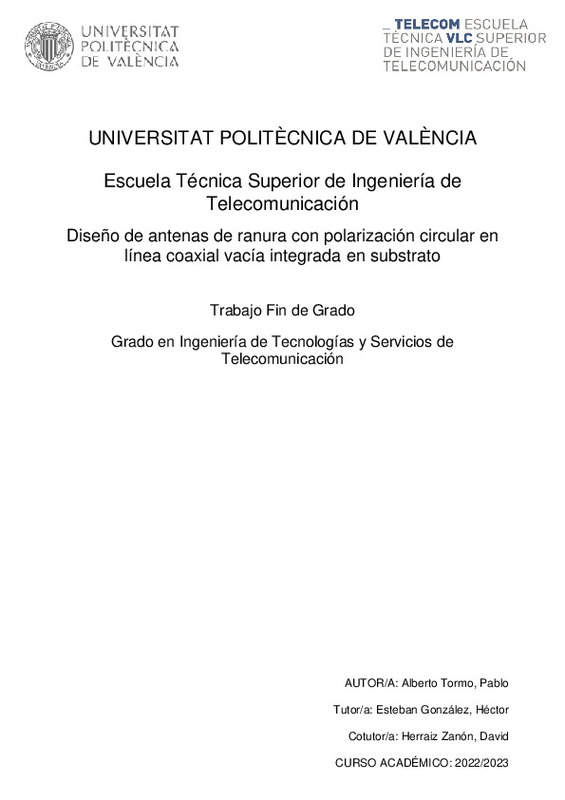|
Resumen:
|
[ES] El progresivo aumento del sector espacial ha dado lugar al desarrollo de nuevas tecnologías que permitan cubrir las necesidades de estos nuevos satélites de dimensiones pequeñas, que requieren de dispositivos de ...[+]
[ES] El progresivo aumento del sector espacial ha dado lugar al desarrollo de nuevas tecnologías que permitan cubrir las necesidades de estos nuevos satélites de dimensiones pequeñas, que requieren de dispositivos de reducidas dimensiones, bajo perfil, y fácil fabricación. En respuesta a esta necesidad, las líneas vacías integradas en sustrato han sido investigadas debido a que encajan con las necesidades, ya que presentan unas características cercanas de las estructuras 3D (guías y coaxiales), pero manteniendo el bajo coste y perfil de las tecnologías planares. En concreto, la línea coaxial vacía integrada en substrato (Empty Substrate Integratred Coaxial Line - ESICL) ha despertado mucho interés, puesto que se propaga un modo TEM, por lo que permite diseñar componentes en un rango de frecuencias muy amplio, miniaturizando los componentes, y además no presenta dispersión. Se han desarrollado múltiples componentes como filtros, transiciones, entre otros, que pueden encontrarse habitualmente en la carga útil de satélites. Sin embargo, los elementos radiantes y en concreto las ranuras han sido poco exploradas en esta nueva tecnología. Por todo ello, en este trabajo final de grado se propone el diseño, desarrollo y fabricación de una antena ranurada en ESICL con polarización circular para el enlace entre satélite y usuario de las constelaciones LEO como Starlink, o OneWeb. Para la realización de este trabajo, el alumno deberá de comprender el funcionamiento de las tecnologías integradas en substrato, así como los conceptos básicos de antenas y polarización, deberá aprender a manejar el simulador electromagnético CST, y desarrollará una antena basada en ranuras que permitan obtener polarización circular, obteniendo así un diseño para finalmente su fabricación y validación.
[-]
[EN] The progressive growth of the space sector has led to the development of new technologies to meet the needs of these new small satellites, which require devices of small dimensions, low profile and easy to manufacture. ...[+]
[EN] The progressive growth of the space sector has led to the development of new technologies to meet the needs of these new small satellites, which require devices of small dimensions, low profile and easy to manufacture. In response to this need, substrate-integrated empty lines have been investigated because they fit the needs, since they present characteristics close to those of 3D structures (guides and coaxial), but maintaining the low cost and profile of planar technologies. In particular, the Empty Substrate Integrated Coaxial Line (ESICL) has aroused much interest, since it propagates in a TEM mode, allowing the design of components in a very wide frequency range, miniaturizing the components, and also has no dispersion. Multiple components have been developed, such as filters, transitions, among others, which can be commonly found in the payload of satellites. However, the radiating elements and in particular the slots have been little explored in this new technology. Therefore, this final degree work proposes the design, development and manufacture of a slotted antenna in ESICL with circular polarization for the link between satellite and user of LEO constellations such as Starlink, or OneWeb. For the realization of this work, the student must understand the operation of the technologies integrated in substrate, as well as the basic concepts of antennas and polarization, must learn to handle the electromagnetic simulator CST, and will develop an antenna based on slots that allow to obtain circular polarization, thus obtaining a design for finally its manufacture and validation.
[-]
|







